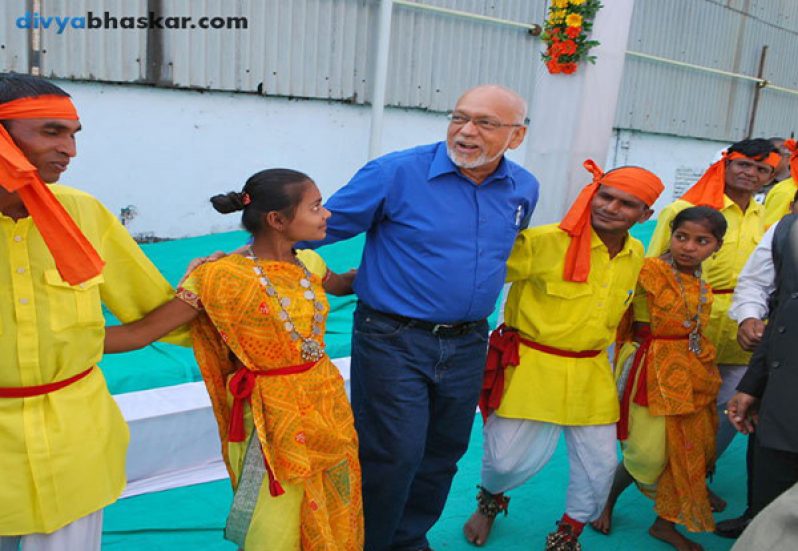WITH Guyana facing an uphill task as it attempts to reduce its cost of production in the sugar industry in light of the falling world market sugar prices, Guyana has turned to India as a possible source of assistance.

President Donald Ramotar is currently in India on an official state visit where he held bilateral discussions with Indian Prime Minister, Narendra Modi, and sugar which serve as one of Guyana’s economic pillars was also on the agenda.
“Since sugar cane is one of Guyana’s important products, the President wanted to know about the facilities and the cooperative movement here,” a Government spokesperson told reporters in India following the bilateral engagement between Ramotar and Modi.
VALSAD VISIT
According to reports, Prime Minister Modi requested President Ramotar’s visit to Valsad (Gujarat) where there is a very active cooperative sector focused on sugar cane.”
The Times of India reported that the President, arrived in the Indian Air Force Chopper at the Valsad College Campus on Friday morning, visited the Valsad District Cooperative Sugar Mill and indicated that he was impressed with the functioning of the sugar factory and praised the state-of-the-art technology to crush the sugar cane to make sugar crystals.
Officials at the ultra-modern plant briefed the Guyanese President and his team of officials regarding the sugar production technology they have adopted.
“Sugar cane production in Guyana is improving, but the country (Guyana) has the technology to produce raw sugar only. India has ultra-modern sugar mills with high white sugar production capacity. The purpose of our visit here is to know the latest and cost-effective technology of sugar production,” the President told the India media corps.
He added that Guyana could achieve growth in sugar production with India’s help, particularly in the area of setting up ultra-modern sugar plants.
Speaking to the management of the Valsad sugar factory and district collector of Valsad, Dr. Vikrant Pandey, Ramotar said that the relation between India and Guyana is very old and that it is going to be further strengthened in the coming days.
PERFORMANCE IMPROVING
Guyana last year for the first time in almost a decade recorded production levels surpassing its projected target when the industry recorded in excess of 216,000 tonnes.
In recent years the sugar industry has been plagued by bouts of inclement weather adversely affecting production levels, which on several occasions were compounded by incidents of industrial action (strikes).
Agriculture Minister, Dr. Leslie Ramsammy only recently expressed optimism that the industry will soon see a turn-around of its fate and return to a state of profitability.
Acknowledging that the 2014 production was a modest one, Dr. Ramsammy noted that the industry is improving from what obtained in previous years and hopes to soon meet a 300,000-tonne target. There is also a projection that the sector would reach a 400,000-tonne goal by 2020.
Regarding the 2015 production targets, the Agriculture Minister told the Guyana Chronicle that it would be set “significantly higher” than the 2014 targets.
“We look forward to 2015, when the target (would be) set significantly higher than the 216,000-tonne target for 2014. I am confident that 2015 will be another successful year in terms of the targets and efficiency of production,” he said.
A $6B allocation for the Guyana Sugar Corporation (GuySuCo) in the 2014 Budget was approved by the National Assembly with the expectation that it covers expenditures that include mechanisation through the conversion of some 2,500 hectares of land. This was earmarked to be done at a cost of $1.1B. Tillage and replanting of 9,200 hectares were also expected to be completed, both efforts being consistent with improving cane production and yield, which will be done at a cost of $1B. Factory upgrading of all sugar estates, including Skeldon, was also slated to be undertaken at a cost of $2B; and works to field infrastructure to improve field-to-factory access, as well as purchasing of equipment, excavators, bell loaders, tractors, etc., were to account for the remainder of the allocation.
Despite its challenges, stark among which is the European Union decision to cease preferential pricing for sugar purchased from Guyana, the industry remains relevant to the health of the national economy, according to the Government. In 2013, sugar exports accounted for 8.3 per cent of Guyana’s total exports, valued at US$112.2M; and the industry contributed 3.9 per cent of the country’s GDP.
The export numbers and GDP contribution percentages for 2014 are expected to be released shortly.




.png)









